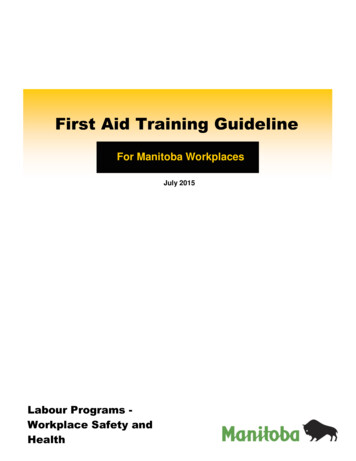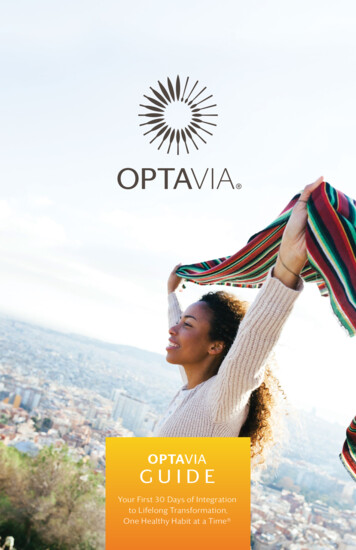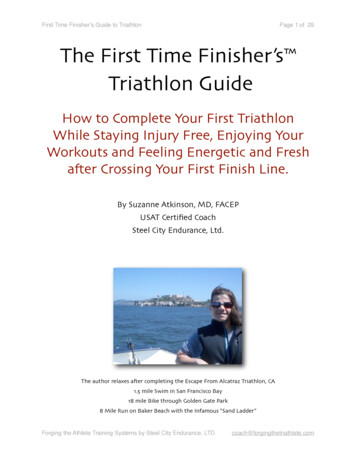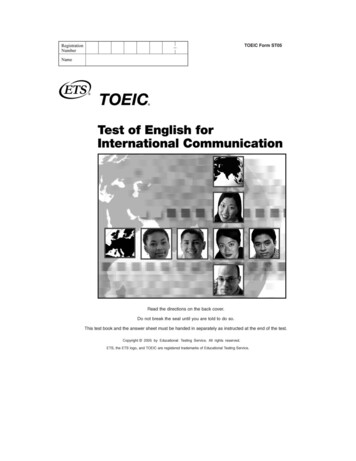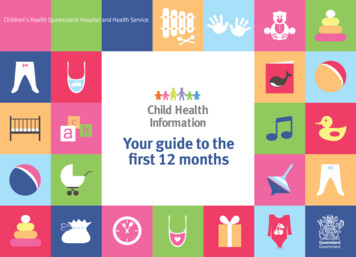
Transcription
Children’s Health Queensland Hospital and Health ServiceChild HealthInformationYour guide to thefirst 12 months
To access this booklet online, go ormation-book
ContentsIntroduction.2Common breastfeeding concerns. 49Bonding.4Sleepy or unsettled baby. 49Common early problems — tender or cracked nipples. 51Swollen breasts, blocked ducts, mastitis. 52Breastfeeding when you are workingor away from your baby. 54When do I stop breastfeeding?. 57Drugs and breastfeeding. 59Keeping your baby safe.5Safety advice for you and your baby. 5Safe sleeping. 10Immunisation. 13How your baby develops. 140–3 months. 153–6 months. 186–9 months. 229–12 months. 27Taking care of your baby’s teeth. 32Taking care of your baby's ears. 34When your child is sick. 36Breastfeeding. 39Best for baby and for Mum. 39Getting started. 41How do I start breastfeeding?. 44Is my baby getting enough milk?. 47Formula feeding. 64Bottle feeding. 64Introducing solids. 68When and why. 68Food allergies. 68Feeding from around 6 months. 70Feeding from 7 to 12 months. 72Feeding from 12 months. 75Recipes for babies. 79Solids guide. 84Physical Activity. 85No screen-time. 86Sun protection. 86Acknowledgements. 87Notes. 881
IntroductionCongratulations on the birth of your baby!Personal Health RecordThis booklet has been produced by Queensland Healthto help answer some of the common questions parentsand carers have about caring for their baby.Your Personal Health Record ("red book") is essential forkeeping your child's records of health, growth,developmental checks and immunisations. There are alsosections for you to fill in to help your health care providerbetter understand your child.It covers the stages of your baby’s development frombirth through to his or her first birthday, plus guidanceon feeding your growing baby.Research has shown that a healthy start in life — includinggood nutrition, a safe and secure environment, a warmand loving relationship with parents and carers, talking,singing and playing in the first year — is the stepping stoneto a healthy life, right through to adulthood.If you would like more information about your child’sdevelopment, health or nutrition, contact your child healthnurse or your doctor. You can also sign up to receive freeparenting news at www.raisingchildren.net.au.The list of emergency and helpful numbers at the backof this book will also point you towards further help.Enjoy your first year of parenthood!Registering your baby’s birth2Your baby's birth must be registered with the Registry ofBirths, Deaths and Marriages (BDM). You will not be able toget a birth certificate until this is done. For moreinformation see the back of the first tab in your child's PHRor visit BDM’s site at www.qld.gov.au/births.Take it with you whenever you take your child to any healthcare provider so they can record the visit, and so otherhealth care providers can see your child's health check andimmunisation history.Child Health Nursing ServiceChild and family health nurses are registered nurses withpostgraduate qualifications and experience in child andfamily health nursing. Many child health nurses holdqualifications in midwifery, and may be lactationconsultants and have extensive paediatric experience.They are able to support families with key health promotioninterventions for children and families as well as evidencebased prevention, health education and anticipatoryguidance.To find your nearest Child Health Clinic call 13HEALTH(13 43 25 84)* If you are having difficulty connecting it may be useful to dial 13 HEALTHusing only the first six digits of the phone number (13 43 25). If you are stillunable to connect to 13 HEALTH then please contact your service provider todiscuss the issue.
Parents' Evaluation of Development Status(PEDS)As a parent you know your child better than anyone elsedoes. You may notice things about your child that concernyou – perhaps even things that no one else has noticed. Itis important that you share these with your health careprovider. Research shows that sharing your concerns aboutyour child can help your health care provider understandyour child better, and may also help pick up any problemsearly. PEDS is a set of 10 tested and reliable questions thatare included at 6, 12, 18 month, and 2½ –3½ and 4-5 yearvisits.Please answer the questions in your Personal HealthRecord book before each designated health check anddiscuss them with the health care provider during thathealth visit to help them better understand your child.The first 5 years last a lifetimeIn their first years of life, your child's brain forms over amillion new connections every second. Simple, everydayactivities with you help to make these connections strong.Talk, read, sing and play together-every day. Join families atyour local library for free and fun baby, rhyme or story timesessions or visit First 5 Forever for activities, ideas and freeweekly tips: www.slq.qld.gov.au/first5forever.First AidParents and carers should consider learning CPR byparticipating in a Paediatric First Aid Class. This can teachyou how to keep calm and give life-saving care in anemergency situation – every second counts.PlaygroupPlaygroup Queensland provides opportunities for everychild to learn through quality play experiences whilesupporting parents and carers in their role as first teachers.Find them on Facebook: Playgroup Qld.Importance of kindyIt’s never too early to enrol your child in kindy. There isextensive evidence-based research demonstrating thatchildren's education and care affects their health,wellbeing and competence throughout their lives. AQueensland Government-approved kindergarten programpositively assists children with their emotional, physical,social and intellectual growth and development.Beyond the first 12 monthsFor information and factsheets on topics beyond the first12 months, visit the Raising Children Network site atwww.raisingchildren.net.au.3
BondingBonding with your babyFor many parents, connecting emotionally with their babyalready started during pregnancy. However the opportunityfor parents and their baby to really get to know each otherand build a relationship begins after birth. This is known asbonding and attachment.The baby's brain undergoes incredible development in thefirst 1 to 3 years of life, so the experiences of a baby’s firstthree years are critical to their physical, social andemotional progress. That is why a baby needs warm,responsive, nurturing care from caregivers – it is throughthese relationships that a baby learns to become who theyare. For more information link to 'Bonding' under'Connecting & Communicating' at raisingchildren.net.au/newborns.Here are some tips for this time. Remember that babies love faces and eye contact.Spend lots of time sharing loving eye contact with yourbaby, while being sensitive to when they need a breakand may look away. Stay connected with them until theyturn their attention back to you. For example, commentsaying “This is hard work, you are getting tired, I will waituntil you are ready”.4 Babies thrive on parents’ love and attention and enjoylots of positive touch in these early days. Some mightsay “you will spoil the baby” but this is impossible whenyou are responding to your baby’s needs. When your baby is upset, try to understand what thismay be like from their point of view and do what you canto comfort them. Talk to your baby often and try to put what your baby isfeeling into words. For example, “You’re so happy to beplaying this game” or “Oh, it’s so sad to be hungry/wet/lonely”. Name actions that you are doing e.g. when dressing baby"One arm through, other arm, over your head !" Overtime, this helps babies learn to predict what ishappening next. Enjoy your baby while following their lead. This will helpyou both to build a sensitive relationship. For example, ifyour baby grabs a new object, sit near them and describeit. Not everyone falls in love with their baby immediately;relationships build over time. Trust your own feelings andmake sure you get support from family and friends or see ahealth professional if you feel like something is not right.Looking after a new baby can be very demanding. Gettinghelp early from family or professionals such as your GP,Child Health Nurse or a counsellor if you experiencedistress, anxiety or depression can help to prevent thedevelopment of more serious issues for you and therelationship with your baby. For more information, contactParentline on 1300 30 1300 or visit the Healthy Familieswebsite: healthyfamilies.beyondblue.org.au.
Keeping your baby safeSafety advice for you and your babyInjury is the leading cause of death among Queenslandchildren.Queensland has one of the highest mortality rates forchildhood injury in Australia. Unfortunately, the home isthe most common place for children’s injuries to occur.As you care for your baby and watch them grow, keepalert to all the ways children can unintentionally hurtthemselves. The most common injuries are falls, drowning(and immersions), burns and scalds, and poisonings.It is important to realise that accidents are not inevitableand, in fact, that most accidents can be predicted andprevented.The aim is not to wrap children up in cotton wool. After all,exploring, taking risks and trying new things are all crucialparts of children’s development. However, it is important toknow where your child is at all times and what they aredoing.To download a comprehensive child home safety checklist,visit www.kidsafeqld.com.au. Reuse this checklist eachyear as your child grows, develops and explores.Caring for your baby Never leave your baby alone on change tables, chairs,beds, tables, chairs or other high furniture. Hold your baby when feeding them a bottle, rather thanpropping them up. Babies can vomit or inhale milk andholding your baby in an upright position will decreasethe risk of ear infections and infant tooth decay. Do not heat your baby’s bottle in a microwave oven.The milk can heat unevenly, risking scalding yourbaby’s mouth. Never handle hot food or drinks, such as tea, coffee ornoodles, while holding your baby. Burns from hot waterand drinks can cause severe scarring to children. Make sure all caregivers are aware that a baby shouldnever be shaken as this can cause brain damage ordeath. For more information visit 12/NAPCAN-Its-NotOk-DL-6pp-1.pdf Keep your baby out of direct sunlight. Use sun protectionmethods, including: shade when possible, SPF30 orhigher water resistant sunscreen, clothing that covers asmuch skin as possible and a broad brim/ bucket orlegionnaires style hat. Sun protection information forinfants is available from Cancer Council Queensland on13 11 20 or www.cancer.org.au.5
Keeping your baby safeSafety advice for you and your baby (continued)ToysClothes and dummies Toys must be safe, durable and washable. If a toyis furry, remember babies can suck on the fur andswallow it. If your baby has a dummy, check it: Toys should not have:- dangling ribbons, long strings or elastic- small or loose parts that can be pulled or chewed off- squeakers that can be removed- sharp edges or points- rattles that can be taken apart- button batteries. Make sure teething rings can’t be pierced. All cuddly toys should be stuffed with old stockings,dacron or polyester. (Crumbled foam, beans and beadscan all be swallowed or pushed into ears or noses.)6- is in good condition- has no ribbons or chains- has holes in the plastic holder for quick,easy removal in an emergency- is only used to settle your baby and not put themto sleep. The use of a dummy after six months of age can increasethe risk of ear infections and associated hearing loss. Remove any loose ribbons or trimmings on clothingbecause they can choke your baby. Look inside mittens and bootees to make sure thereare no loops or threads that can wind around your baby’sfingers and toes because they can cut off circulation. Remove all head covering before placing your babyto sleep as they may overheat or become entangled.
Bath time Always check the temperature of the water with yourwrist or elbow before putting your baby in the bath. Never leave your baby alone during bath time —not even for a minute. Babies should never be left in the care of older children,no matter how reliable they seem. Check that your home has a properly functioning hotwater tempering device installed and set at the righttemperature (50 C).Around your homeYour baby is very mobile and eager to explore. Checkyour house thoroughly and often to keep your baby safe. Button batteries are in many products, they areextremely dangerous if inserted (nose, ear) orswallowed. Identify items with button batteries in them,secure the battery compartment, keep them out of reachof children and dispose of them safely. If you think yourchild has swallowed or inserted a button battery,immediately call the 24 hour Poisons Information Centreon 13 11 26 for fast, expert advice. Always ensure your baby is strapped in securely whenin a bouncer, stroller or high chair. Always keep one hand on your baby or toddler while theyare on the change table. Wherever your child is playing, always look to make surethere are no objects within reach that are small enoughto swallow. As a guide, anything small enough to fitinside a toilet roll is small enough for your baby toswallow. You may need to look at the room from theactual eye level of your child. Install smoke detectors throughout your home, checkthem and change the batteries regularly. This will protectnot only your baby but the whole family. Contact yourlocal fire service for more information. Carefully supervise any interactions between your babyand animals, especially dogs — particularly when dogsare feeding, sleeping or with new puppies. Make sureyour baby is never left unsupervised near any family petswhen at home or out. As your child starts using their mouth to taste everythingaround them, be aware of the dangers of poisoning.Install a lockable cupboard, preferably up high, in thekitchen, bathroom, laundry and garage to storepoisonous materials. Do not pour or decant chemicalsinto another container (especially food or drink bottles). Remove all alcohol from your baby’s reach (especiallyafter a party). It only takes a small amount of alcoholto poison a baby.7
Keeping your baby safeSafety advice for you and your baby (continued) Be aware that hand sanitisers often used in the nappybag contains alcohol and is not fitted with a childresistant cap. Keep hand sanitiser out of reach ofchildren.Out and about Avoid smoking near your baby. Keep cigarettes, lighters,ashtrays and cigarette butts out of the reach of children.Cigarettes and butts are poisonous to children. Never leave your baby alone in the car — not even fora minute. Check your home has a proper electrical safety switchinstalled and operating to prevent electrocution. Every outside play area should be fenced off fromthe street, pool/spa and driveway. On rural properties,a special fenced area away from any dams or waterwaysshould be set aside as the children’s play area. Consider swimming lessons to help develop thenecessary skills and confidence they need to be safer inand around the water. Some swim schools offer freelessons for young babies. Ensure your baby doesn't gettoo cold as they can’t regulate their temperature likeadults. Make sure baby is protected from the sun withappropriate clothing. For more tips and precautions ing. Be aware of pool hygiene. For tips on this, visitraisingchildren.net.au and search for 'pool hygiene'.8 Every time your baby travels in a car they must berearward facing in an Australian Standard approvedbaby capsule or child car restraint. Baby must be unwrapped before being placed in thechild car restraint, baby capsule, stroller or pram. Do not use a sling/pouch that places the baby on their back ina curled ‘C’ position. Use an upright carrier that properlysupports the baby’s back, under the bottom and knees,high on the parent’s chest with face and nose uncovered. Donot use a carrier while cooking or preparing food. Always know where your baby is before reversingyour car. Always make sure your baby is strapped in securelywhen they’re in a shopping trolley or stroller to preventfalls. Always stay with them. As your child explores the backyard, be aware ofpossible hazards including poisonous or irritatingplants, mushrooms, any unfenced water, sharp objects,insects and animals. For more information call the Queensland Governmenthelpline on 1300 369 003, Kidsafe Queensland on3854 1829 or contact your local ambulance station.
Effects of smoking and vaping on babies andchildrenBabies and children are at a higher risk of damage frompassive smoking than adults because of their smallerdeveloping bodies, higher breathing rates and lessdeveloped respiratory and immune systems.Babies and children who are exposed to second-handsmoke are at risk of SIDS. Smoking and vaping are one ofthe most important modifiable risk factors in reducing therisks of sudden infant death. Smoking and vaping alsoincreases the risks of children developing respiratoryissues such as bronchitis and pneumonia as well as regularear infections and associated hearing loss.Cigarettes and electronic cigarettes contain harmfulsubstances that can cause cancer. Babies are exposed tothese harmful toxins and substances in fine particles thatcan be inhaled. The vape and e-cigarette cartridges are notcontained in child proof packaging and can be ingested bya child.You can reduce your children’s exposure to cigarettesmoke by: Quitting keeping your car and home as smoke-free zones (InQueensland, it is illegal to smoke in a car with a childunder the age of 16 years). designating outside smoking areas away from openwindows and doors, and using a smoking shirt over yourclothes smoking after feeding your baby, not before changing your own and your baby’s clothing often duringthe day to remove contaminants not bed-sharing with your baby if you are a smoker not smoking while you are pregnant.Parents are role models for their children, so setting anexample by not smoking can reduce the likelihood of yourchildren taking up smoking.Quitting smoking is the best thing you can do for you andyour child’s health. Queensland Health’s Quitline serviceprovides a free quit smoking program for parents/carers/guardians of children aged 3 and under. The ‘Smoke-freeFamily’ program combines a series of quit smoking supportcalls (delivered over the phone) with a 12-week supply ofNicotine Replacement Products (these are posted to you) tohelp you confidently on your way to a smoke free future. Tojoin, call Quitline on 13 78 48 and mention ‘Smoke-freeFamily’.Drinking alcohol after the birth of your babyAlcohol can affect your coordination and reaction time andcan cause drowsiness. When you or your baby’s carer hasthese effects, your baby may be at increased risk of injury.The national alcohol guidelines recommend that not drinkingis the safest option when supervising or caring for children.Drug use after the birth of your babySide effects from taking drugs may mean you are not ableto respond to your baby’s needs as easily. If you or yourbaby’s carer is less responsive as a result of these effects,the baby may be at increased risk of injury. Some types ofdrugs can have a sedative effect and others may make youvery tired even after the drug wears off.9
Keeping your baby safeSafe sleepingTo help your baby sleep safely and reduce the risk ofsudden infant death: sleep baby on the back from birth, not on the tummy orside sleep baby with head and face uncoveredTo provide a safe sleeping environment for an infant: put your baby’s feet at the bottom of the cot make sure the cot meets the Australian standard for cots use a firm, flat, clean mattress that fits snugly in the cot keep baby smoke free before birth and after ensure no additional mattresses or extra padding areplaced in a travel or porta cot provide a safe sleeping environment night and day tuck in bedclothes securely so bedding is not loose sleep baby in their own safe sleeping place in the sameroom as an adult care-giver for the first 6 to 12 months keep quilts, doonas, duvets, pillows, cot bumpers,sheepskins and soft toys out of the cot or sleeping place. breastfeed baby if and when you can. Inclined sleepers are not recommended.An infant sleeping bag that is the correct size for your babywith a fitted neck, arm holes or sleeves and no hood is asafe and effective way to keep your baby’s head and faceuncovered, as it makes extra bedding unnecessary. If usinga swaddle bag, when baby can roll onto the tummy ensurearms are free from the swaddle.Back to sleepTummy to playSit up to look at the world.10Bouncinettes, rockers, prams, strollers and child car seatsor carriers have NOT been designed as sleeping productsand therefore no baby should be left unsupervised if theyfall asleep in these environments.
Sleeping with your babyIn many families, the mother or father shares the samebed or sleep surface as their baby. In some circumstances,sharing the same sleep surface may increase the risk ofsudden infant death.If you choose to share the same sleep surface with yourbaby, the following guidelines may make it safer. Sleep your baby on their back from birth – never on theirtummy or side. If your baby lies on his or her side to breastfeed, he orshe should be returned to the supine (back) position forsleep. Make sure the mattress is firm and flat. Make sure that bedding cannot cover your baby’s faceor overheat your baby (use lightweight blankets andremove pillows, doonas and other soft items from theenvironment that could cover your baby). Sleep your baby beside one parent only, rather thanbetween two parents, to reduce the likelihood of yourbaby becoming covered by adult bedding. Ensure your partner knows your baby is in the bed. As an alternative to bedding, an infant sleeping bagmay be used so that your baby does not share theadult bedding. Do not ‘wrap’ your baby if you are sharing a sleepsurface, as this restricts arm and leg movement. Make sure your baby cannot fall off the bed. A saferalternative is to place the mattress on the floor (but beaware of potential situations where your baby canbecome trapped). Pushing the bed up against the wall can be hazardous.Babies have died after being trapped between the bedand the wall. Never place your baby to sleep in a bed with otherchildren or pets. Never leave your baby alone on an adult bed, or put yourbaby to sleep on a sofa, beanbag, waterbed or soft,sagging mattress. Three sided cots that attach to the side of the bed are notsafe or recommended. A four sided cot with the drop sidedown, positioned beside the bed, provides a safesleeping environment close to a parent during sleep. Sharing a bed with your baby while under the influenceof alcohol, a drug that causes sedation or alters yourlevel of consciousness, or when you are very tired,increases your baby’s risk of Sudden Unexpected Deathin Infancy (SUDI) and fatal sleeping accidents.11
Keeping your baby safeSafe sleeping (continued)WrappingFor some babies, wrapping them in a lightweight cottonor muslin wrap will help them to settle and sleep.Wrapping is a safe and effective strategy to assist youto settle your baby.If you choose to wrap your baby, make sure: your baby is placed on their back while wrapped your baby’s face and head are not covered your baby is not overdressed under the wrap the wrap is firm, not tight Place your baby on their back to sleep. Change your baby’s head position every sleep. Have lots of tummy time when awake. Regularly change the position of toys that your babylikes to look at. Encourage your baby to turn his or her head to either sidewhen you talk or play with him or her. you modify the wrap to meet developmental changese.g. arms are free once ‘startle’ or Moro reflex beginsto disappear (around 3 months of age) Put your baby to sleep at either end of the cot orreposition the cot to face a different direction. your baby is not bed-sharing or sharing a sleep surfacewith another person while wrapped. Avoid prolonged periods in car seats, strollers, swingsand bouncers.When your baby can roll from their back to their tummyand then back again when you are watching them (usually4–6 months), you can stop using the wrap for settling andsleep. Wrapping them may stop an older baby who hasturned onto their tummy during sleep from returning tothe back sleeping position. Do not change to a softer mattress.For more information12Strategies to reduce the risk of positionalplagiocephaly (flattened area on the head)developingContact SIDS and Kids on 1300 308 307 or visit the websiterednose.org.au Carry your baby in the upright position. Do not change your baby’s sleeping position to a sideor prone (tummy) position. Do not use a pillow or roll to keep your baby’s headin position. Do not use ‘sleep positioners’ or ‘wedges’ to keep babyon its back or side.
Keeping your baby safeImmunisationImmunisation is a simple and effective way of protectingchildren from serious diseases including meningococcal C,measles, mumps, German measles (rubella), polio,Haemophilus Influenzae type B, whooping cough(pertussis), hepatitis B, pneumococcal disease, rotavirus,chickenpox (varicella), influenza, tetanus and diphtheria.These diseases can cause hospitalisation, serious ongoinghealth conditions (including cancer, brain damage anddeafness) and are sometimes fatal.There is a strict timeframe for rotavirus vaccination and noopportunity to catch up missed vaccination/s. Your baby’svaccinations commence at birth and rotavirus will be givenat the same time as other vaccines.Annual influenza vaccination is recommended and NationalImmunisation Program (NIP) funded for all children 6months to 5 years. It is also recommended for all people 5to 65 years of age.Refer to the schedule in your baby’s Personal Health Recordto keep track of when your baby’s immunisations are dueand make sure you take the PHR with you whenever youtake your baby for vaccinations so the Official VaccinationRecord can be filled in. You might need this when enrollingyour child in child care or school.Vaccinate on timeIt is really important for your child to be vaccinated on timeand according to the immunisation schedule. Delaying orsplitting vaccines on the schedule can potentially exposeyour baby to dangerous vaccine preventable diseases. Yourchild isn’t fully protected if vaccinations become overdue.Contact your GP or Child Health Nurse for further advice.Vaccines for parents and carersWhile babies are still too young to have completed thefull set of immunisations, the best way to protect themis by the parents and carers being immunised. This isparticularly important for whooping cough and influenza.Whooping cough (or pertussis) is a highly contagiousdisease spread by direct contact with infected nose ormouth
Talk to your baby often and try to put what your baby is feeling into words. For example, "You're so happy to be playing this game" or "Oh, it's so sad to be hungry/wet/ lonely". first 1 to 3 years of life, so the experiences of a baby's first Name actions that you are doing e.g. when dressing baby




